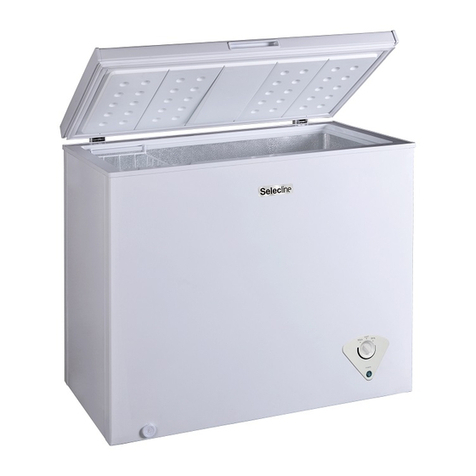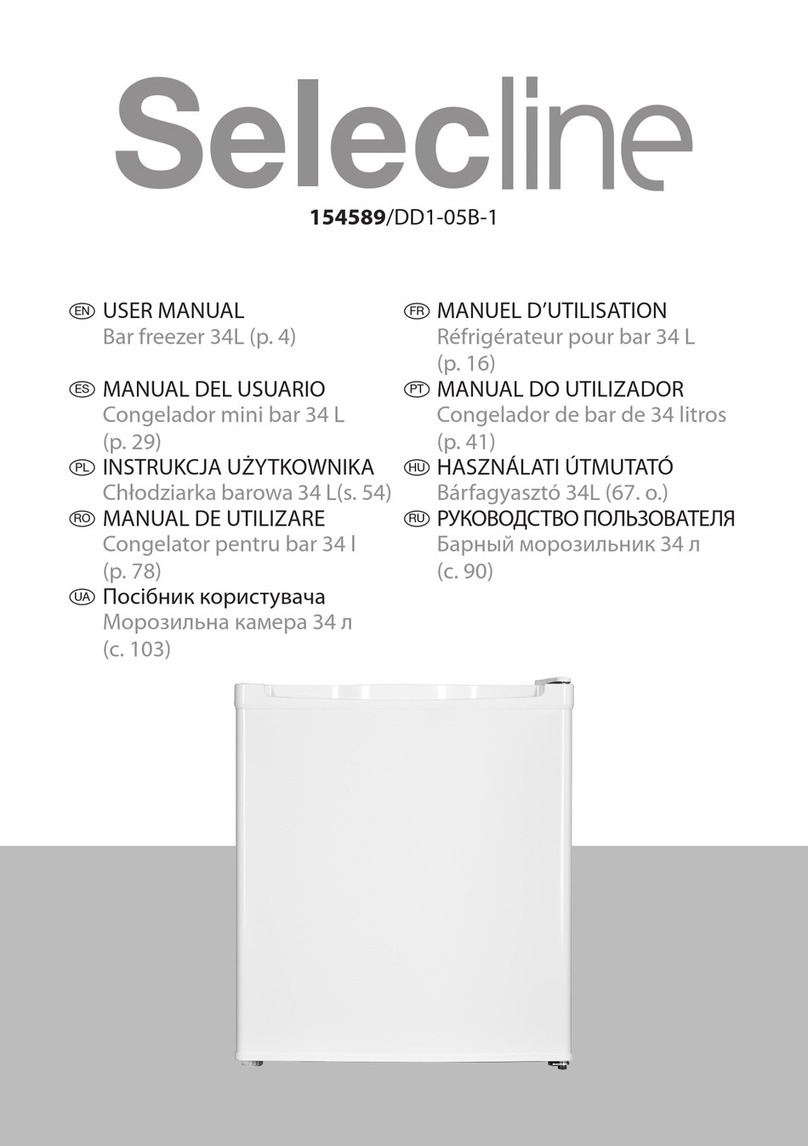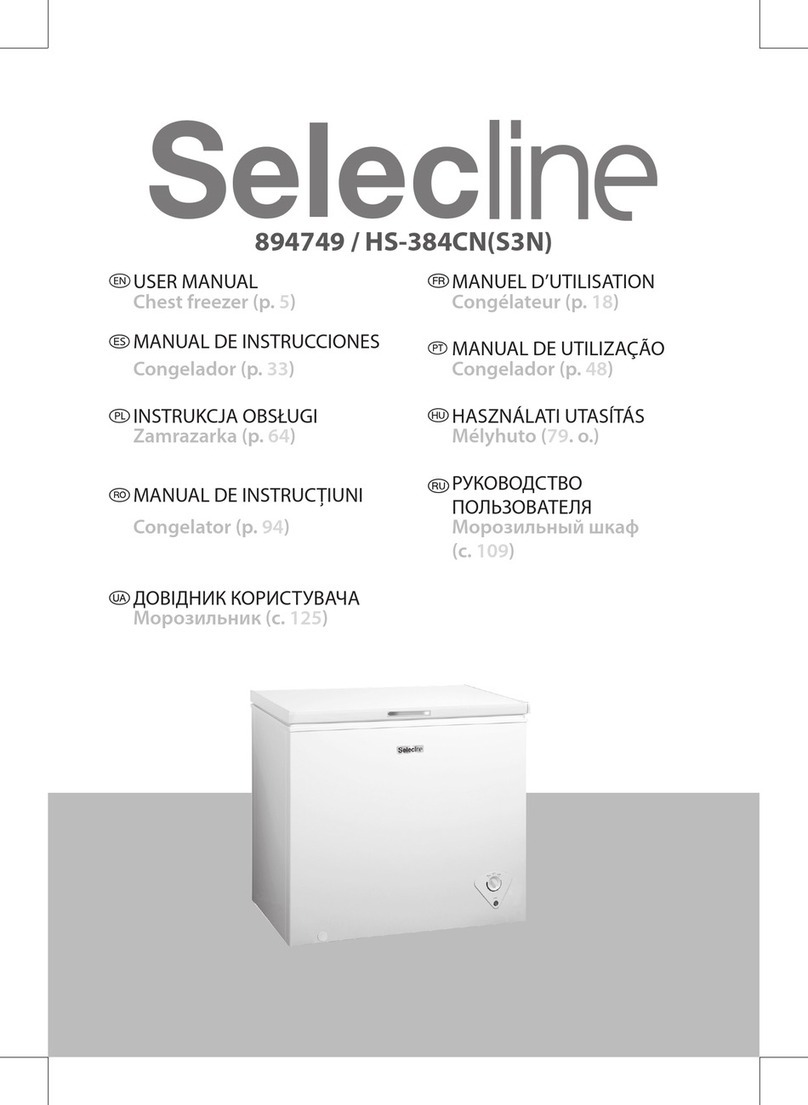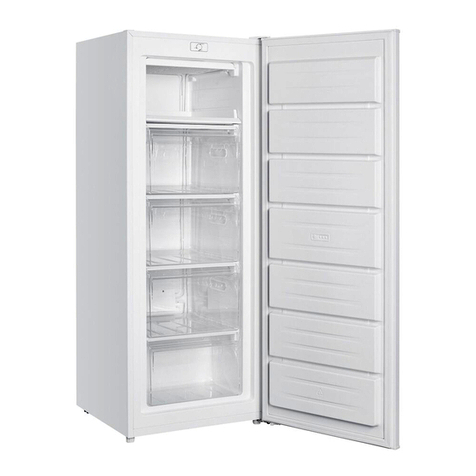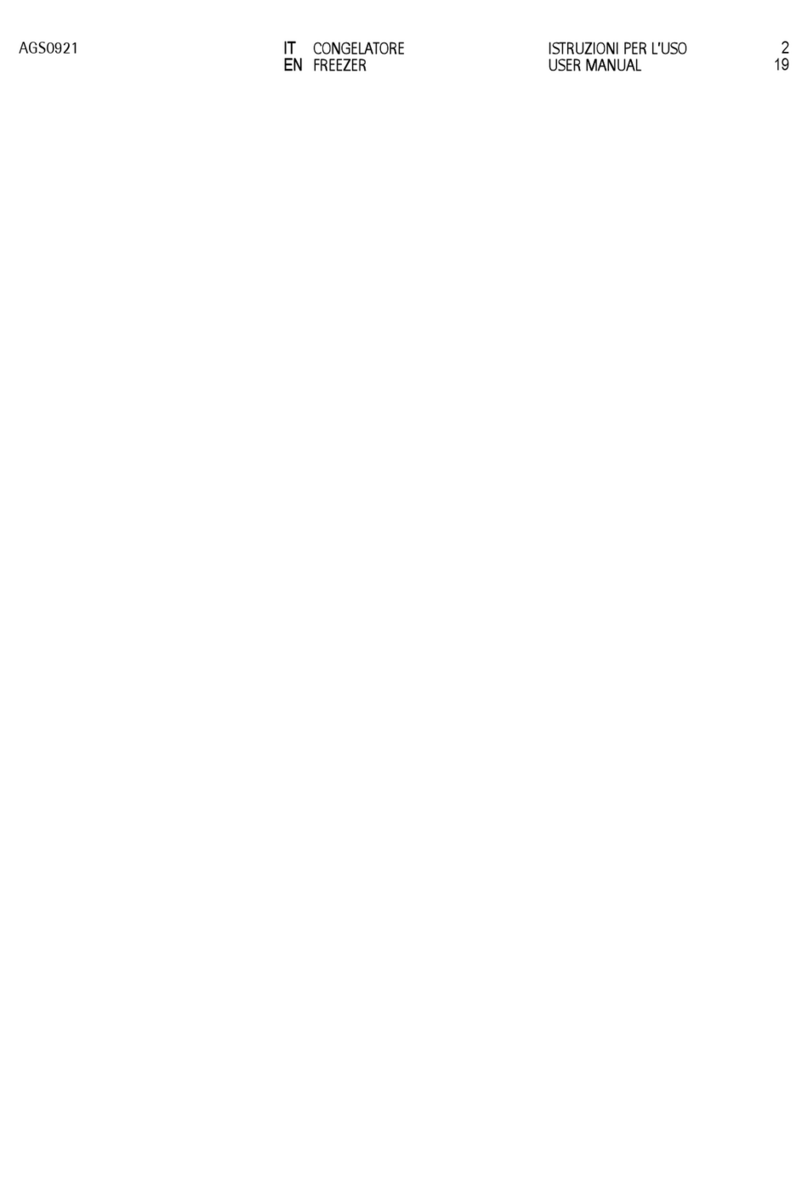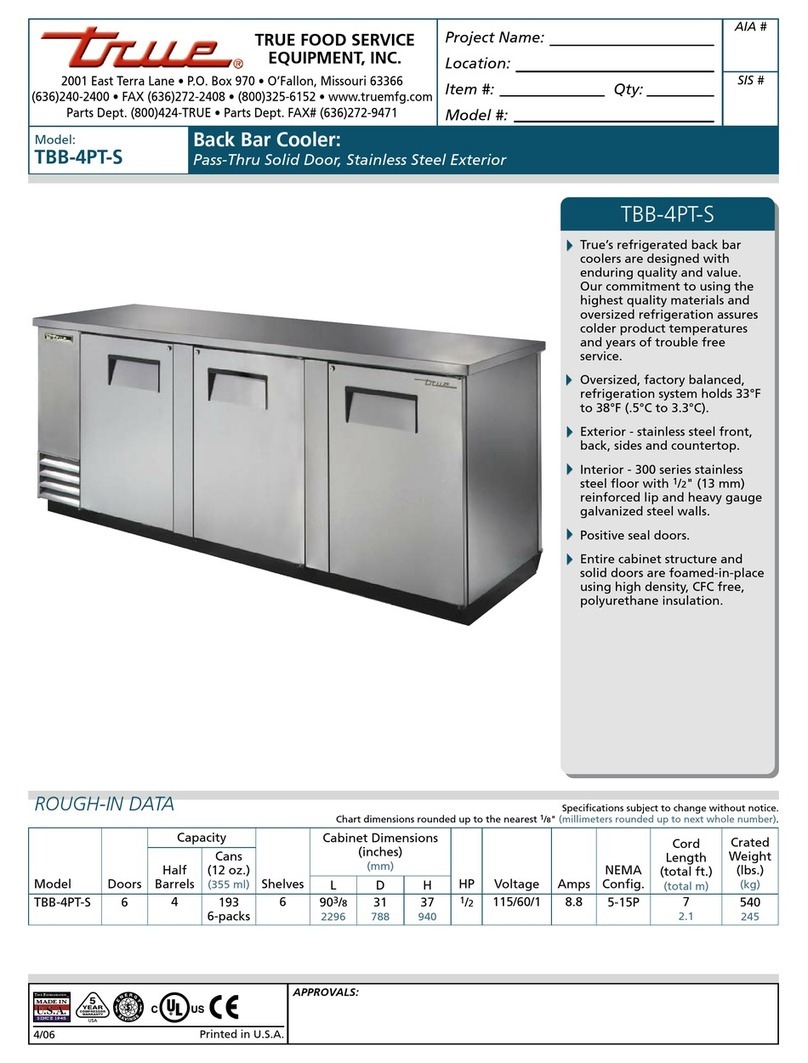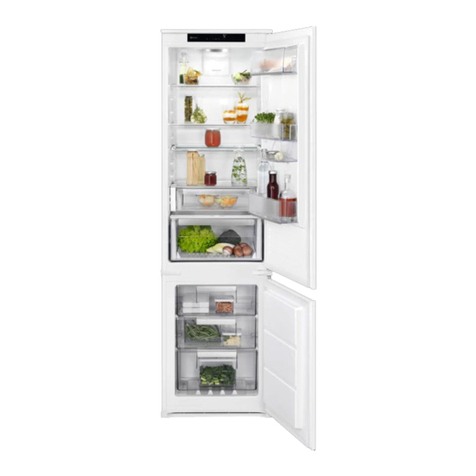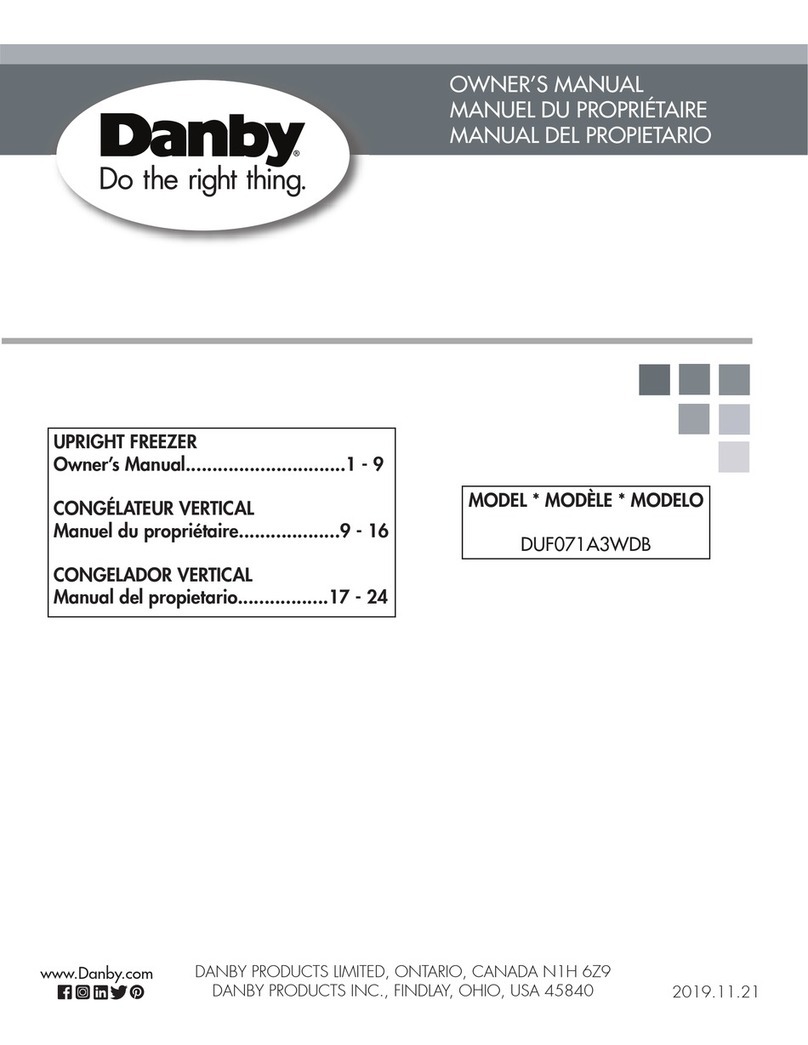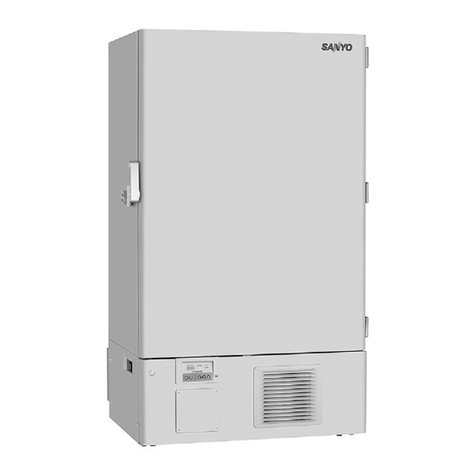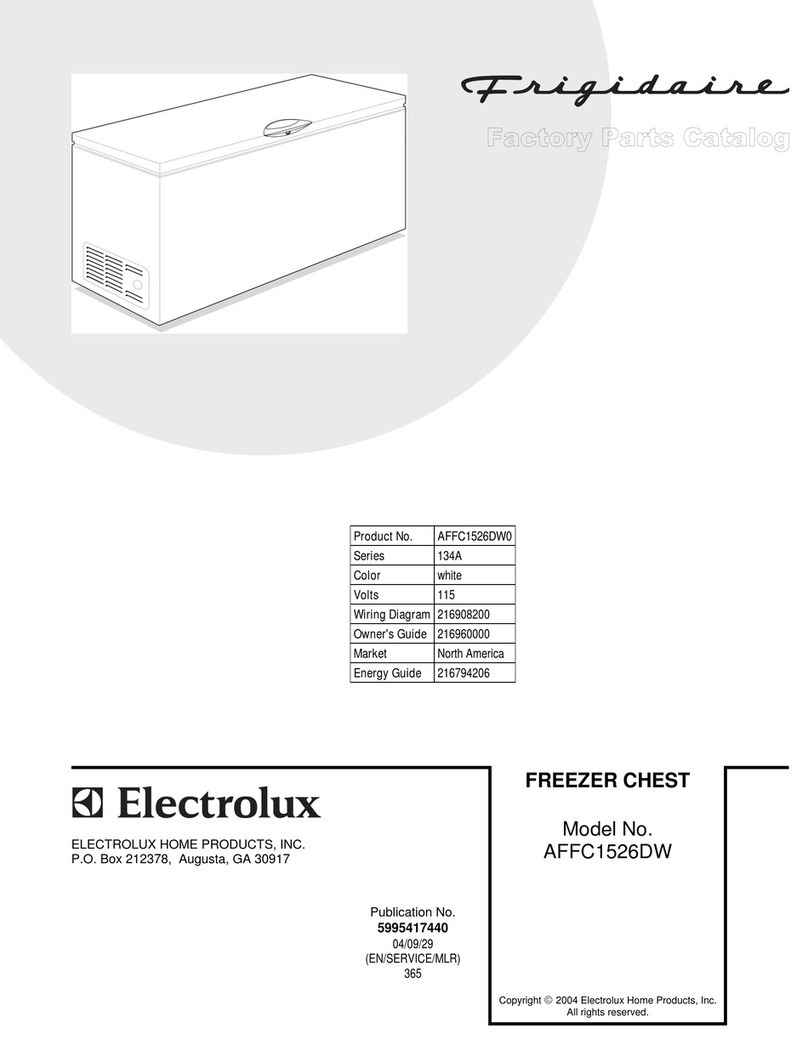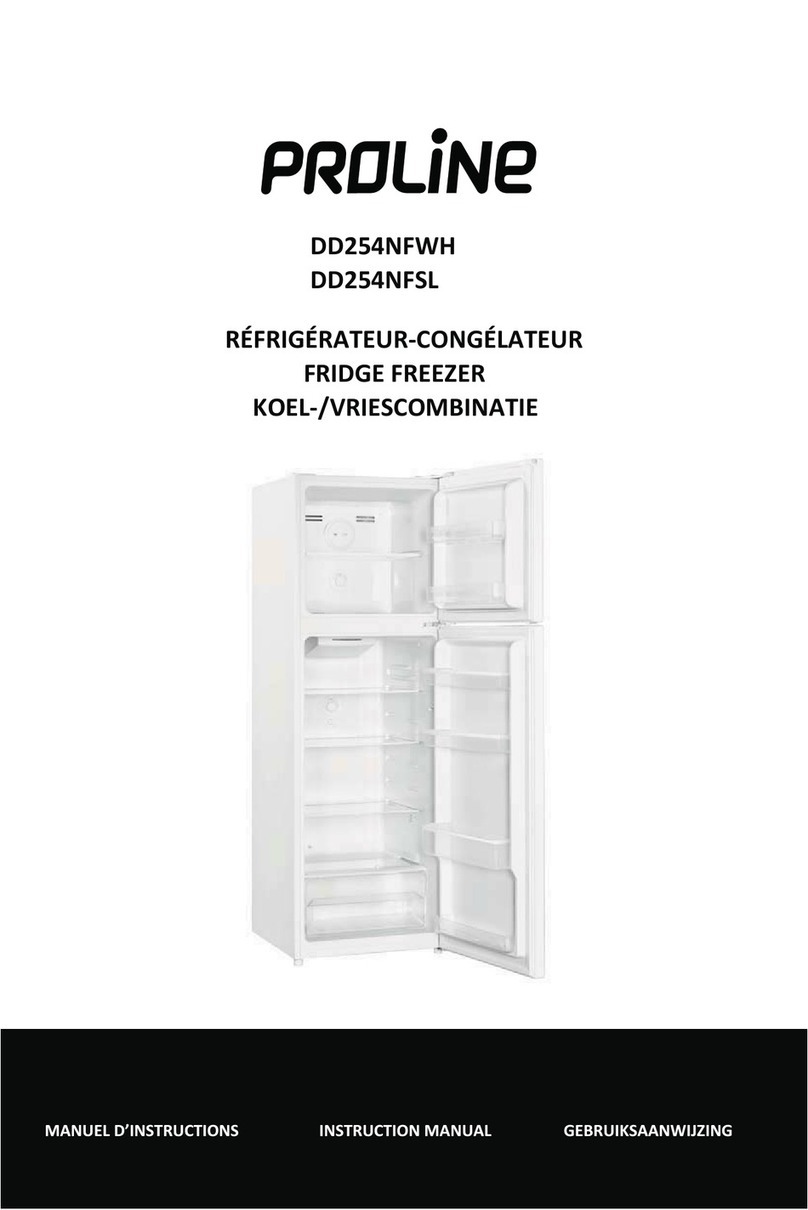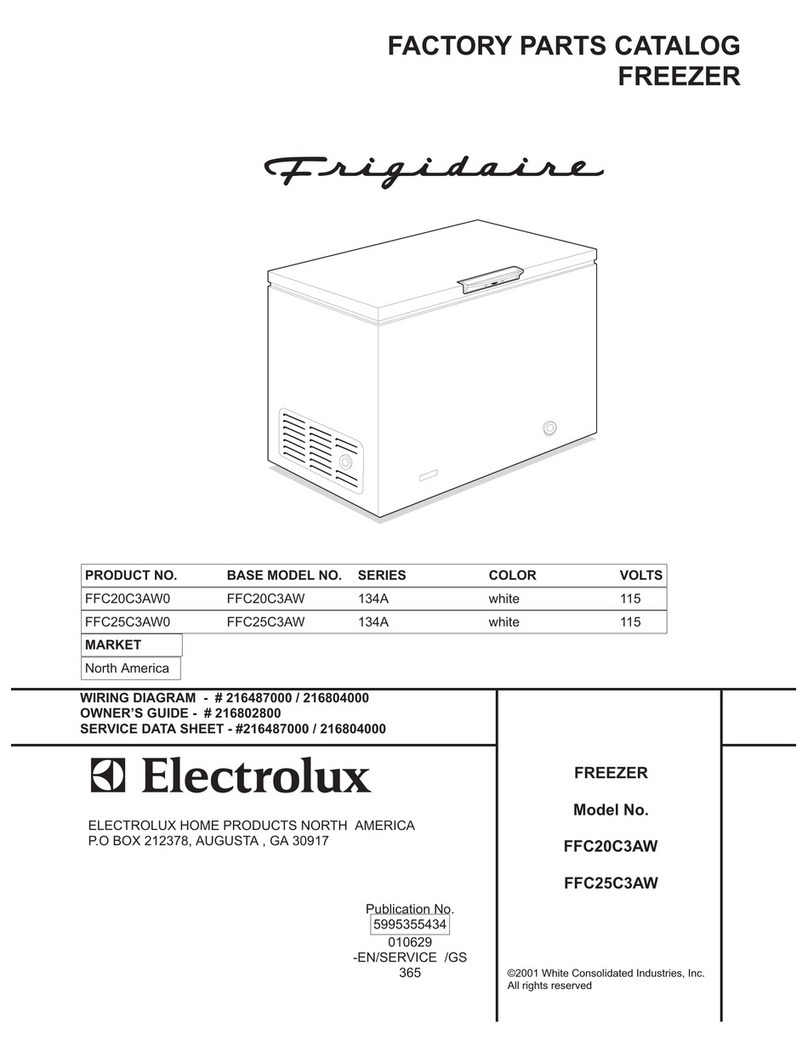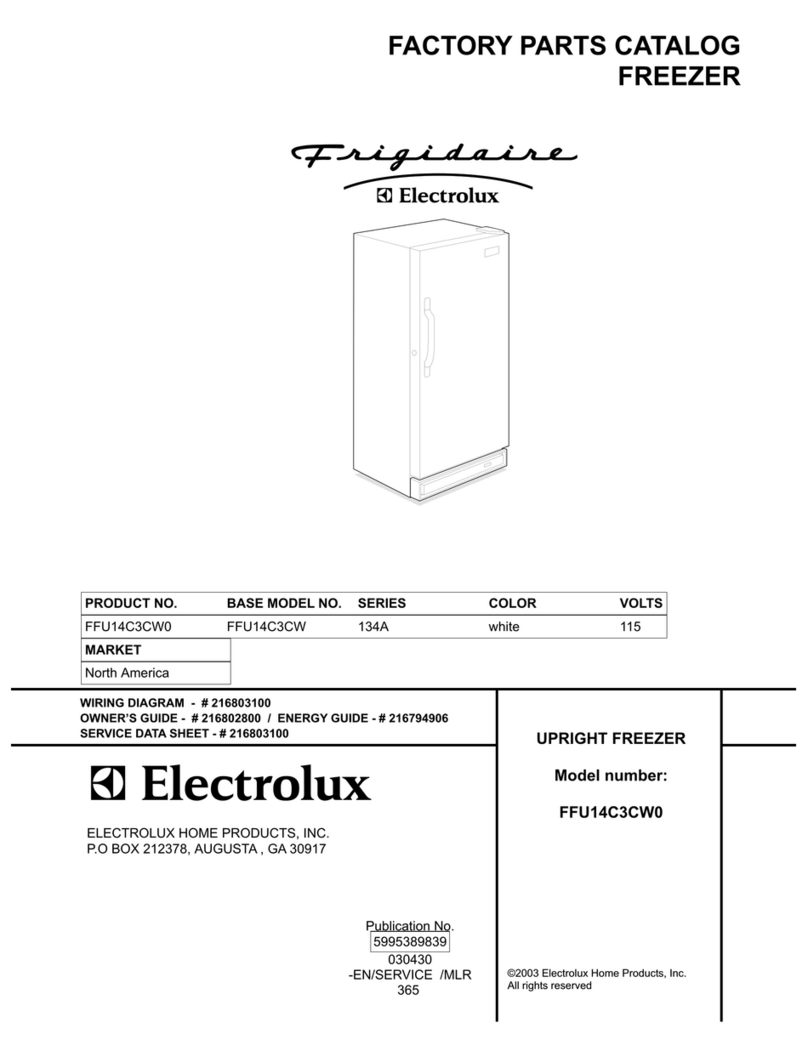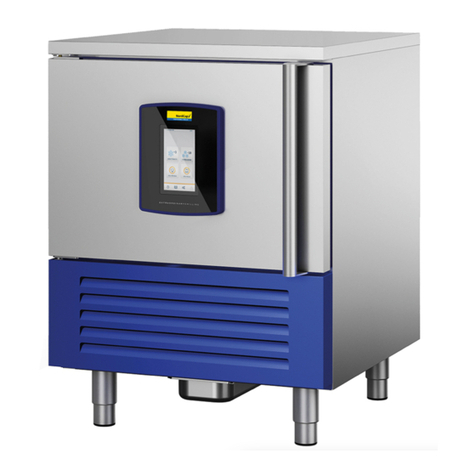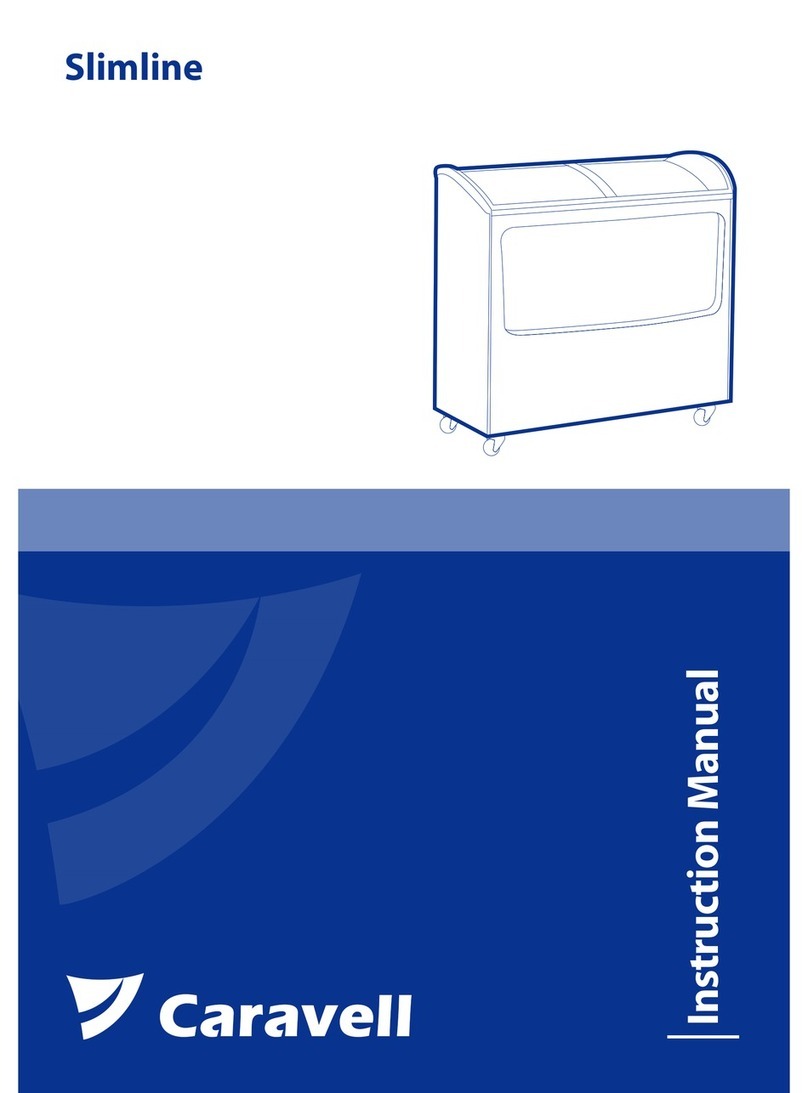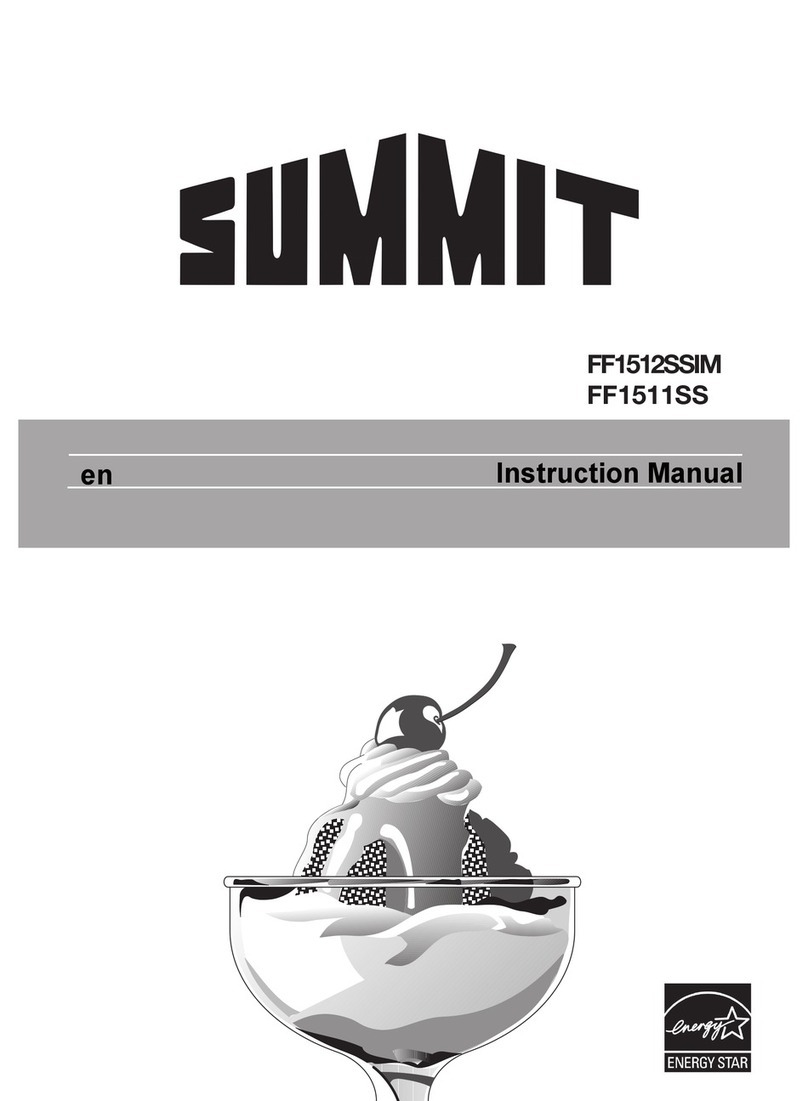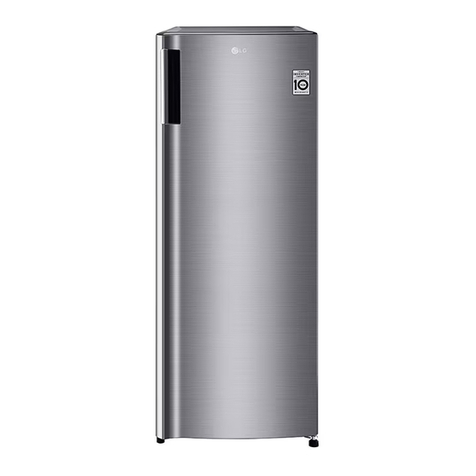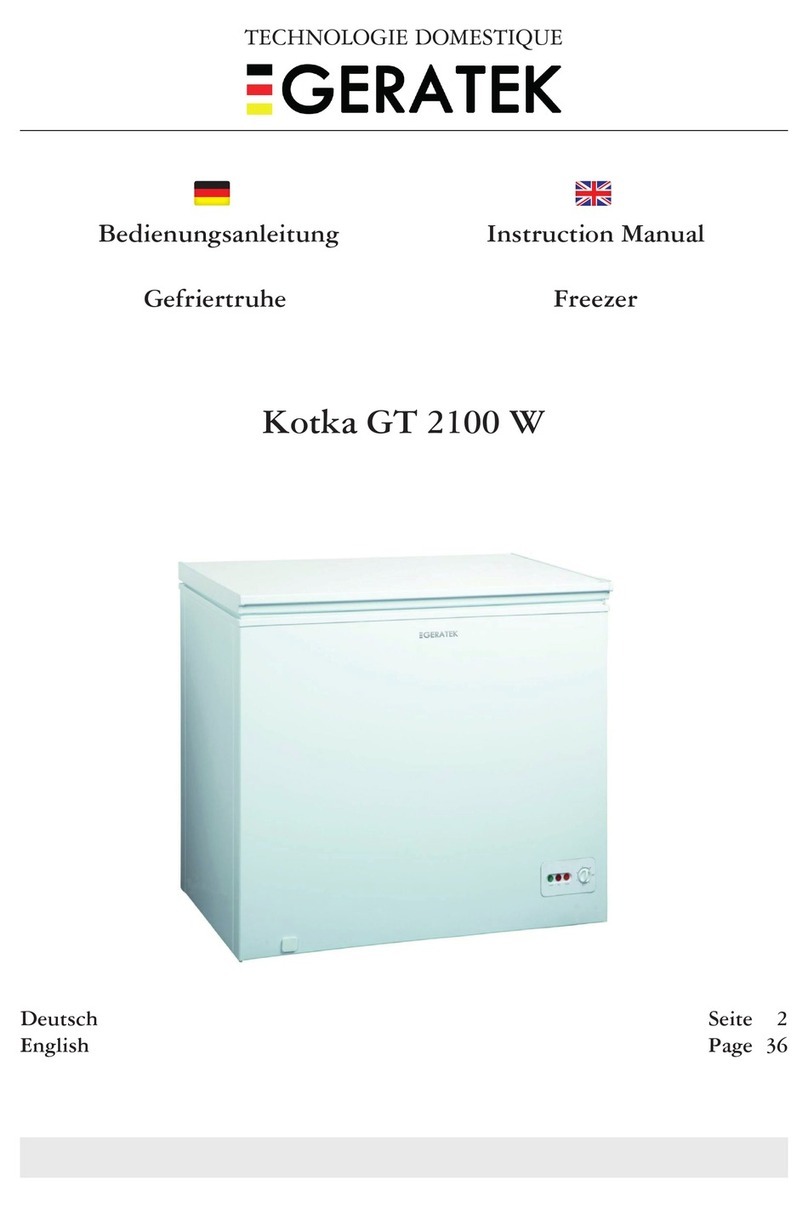Selecline 600081542 User manual

600081542
DD1-21-4
USER MANUAL
Freezer (P.03)
MANUAL DE UTILIZACIÓN
Congelador (P.36)
INSTRUKCJA OBSŁUGI
Zamrażarka (S.66)
MANUAL DE UTILIZARE
Congelator (P.97)
ІНСТРУКЦІЯ З ЕКСПЛУАТАЦІЇ
Морозильник (C.128)
MANUEL D’UTILISATION
Congélateur (p.20)
MANUAL DE UTILIZAÇÃO
Congelador (P.51)
HASZNÁLATI ÚTMUTATÓ
Mélyhűtő (82.o.)
РУКОВОДСТВО
ПОЛЬЗОВАТЕЛЯ
Морозильный шкаф (C.112)

4
5
3
2
1
2

unscrew
3 4
5
1 2

A 0
B 0
C 1420
D min= 0
E min=50
F min=50
G
H
I 135°
1130
960
F F
F
6 7
8 9
10
4

11
12

1/ SAFETY INSTRUCTIONS
Before using this electrical appliance, read the instructions
below carefully and keep them for future reference:
1. Before plugging the appliance into a wall socket, check
that the local electric current corresponds to the current
specied on the rating plate axed to the appliance. Always
plug your appliance into an earthed wall socket.
2. If the supply cord is damaged, it must be replaced by a
special cord or assembly available from the manufacturer or
its service agent.
3. A special plug is installed with your appliance’s power
cable.This plug must be plugged into an earthed wall socket,
with a power of at least 16 amps. If you do not have such a
wall socket, please have it installed by a qualied electrician.
4. Do not use with a programmer, timer, remote command
system or any other device that powers on the appliance
automatically.
5. Do not use an extension or multi-socket adapter.
6. Risk of electric shock! Do not try to repair the appliance
yourself. In the event of a malfunction, repairs must be
carried out by qualied personnel.
7. Do not touch the plug with wet hands.
8. This appliance can be used by children aged at least 8
years old and by persons with reduced physical, sensory
TABLE OF CONTENTS:
1/SAFETY INSTRUCTIONS ______________________________ P. 6
2/TECHNICAL SPECIFICATIONS_________________________ P. 10
3/PRODUCT DESCRIPTION_____________________________ P. 10
4/BEFORE FIRST USE __________________________________ P. 11
5/USE _______________________________________________ P. 13
6/CLEANING AND CARE _______________________________ P. 18
7/WARRANTY AND LIMITATION OF LIABILITY ____________ P. 19
6

or mental capacities or without experience or knowledge,
it they are properly monitored or if instructions for safely
using the appliance have been given to them and if the risks
involved are understood.
9. Children must not play with the appliance.
10. Keep the openings of the room in which the appliance is
located open.
11. This appliance is built exclusively for domestic and
similar use, such as in:
- kitchen spaces for sta in shops, oces and other
professional environments;
- hotels, motels and other residential environments;
- environments akin to B&Bs.
- restaurants and other similar sectors, excluding retail.
12. Do not use mechanical devices or other means aside
from those recommended by the manufacturer to speed up
the defrosting process.
13. Do not use electrical devices inside the refrigerator.
14. Do not damage the refrigerant circuit.
15. Keep the ventilation openings in the appliance’s
enclosure or in the frame structure free from obstruction.
16. The refrigerant gas R600a contained in the refrigerator
is an environmentally safe, combustible natural gas. As
such, it is important to transport and install your refrigerator
carefully so as not to damage the refrigerant pipes. In the
event of a bump or gas leak, avoid all contact with a ame or
replace nearby and ventilate the room.
17. It is recommended not to use sharp metallic objects or
other articial objects to speed up the defrosting.
18. Do not store explosive substances such as aerosol
dispensers with ammable propellant in this appliance.
19. The appliance cannot be built into a piece of furniture or
in a practical accommodation, in a wall or in similar locations.
7

20. To prevent the appliance from deteriorating in any way,
transport it in its usage position equipped with its transport
brackets.
21. Unplug the power cable from the power socket before
maintenance or cleaning.
22. To avoid any risks related to the instability of the
appliance, it must be secured according to the instructions.
23. Tips for cleaning and defrosting the appliance are
provided in the“Cleaning and Maintenance”chapter.
24. Defective electrical appliances must be recycled,
not disposed of with household waste. Please
actively help us in our eorts to preserve resources
and protect the environment by disposing of this appliance
at dedicated collection centres and rubbish dumps.
25. This appliance is only appropriate for storing food. The
refrigerator must not be used for other purposes, such as
storing blood or medicine.
26. Risk of suocation! Keep all packaging materials out of
the reach of children and babies!
27. Recycle the packaging materials in accordance with
regulations. Ask local authorities where dedicated collection
centres and rubbish dumps are located.
28. Children aged 3 to 8 are permitted to use refrigeration
appliances to put away and take out food.
29. WARNING: Risk of re/ammable materials
30. WARNING: When you position the appliance, make sure
the power cable does not get caught or damaged.
31. WARNING: Do not place a multi-socket or extension
adapter behind the device.
32. To avoid contamination of food, follow the instructions
below:
- Opening the door for long periods can cause a
signicant increase in the temperature of the appliance’s
compartments.
8

- Regularly clean surfaces that may come into contact
with food and accessible drainage systems.
- Clean water tanks if they have not been used for 48
hours; ush the water system connected to the water supply
if water has not been drawn for 5 days.*
- Store raw meat and sh in suitable containers in the
refrigerator to ensure that it does not come into contact
with or drip onto other food.
- Two-star frozen-food compartments are suitable
for storing pre-frozen food, storing or making ice-cream and
making ice cubes.*
- One , two , three-star and four-star
compartments are not suitable for freezing fresh
food.*
- If the refrigerating appliance is left empty for long
periods, switch o, defrost, clean, dry, and leave the door
open to prevent mould developing within the appliance.
- For appliances without a 4-star compartment: this
refrigerating appliance is not suitable for freezing food. *
*Note: Please conrm whether this is applicable according
to your product compartment type.
33. Dispose of the appliance according to local regulations
as it contains a ammable refrigerant gas.
34. This appliance can be used by children aged 8 years
and above and persons with reduced physical, sensory or
mental capabilities or lack of experience and knowledge,
provided that they have been given supervision or
instruction concerning use of the appliance in a safe way
and understand the hazards involved. Children must not
play with the appliance. Cleaning and user maintenance
tasks must not be done by children without supervision.
Children aged 3 to 8 years are allowed to load and unload
refrigerating appliances.
35. For freestanding appliances: this refrigerating appliance
is not intended to be used as a built-in appliance.
9

36. Warning: To prevent hazards caused by an unstable
appliance, the appliance must be xed in place in accordance
with the instructions.
37. To prevent children from becoming entrapped, keep the
appliance out of reach of children and do not allow them to
play in the vicinity of the freezer (or refrigerator). (Suitable
for products with locks).
38. The symbol indicates the coldest area of the
refrigerator. It denes the top of this area.
39. All accessories, such as drawers, shelves balconies,
should be kept there for lower energy consumption.
2/ TECHNICAL SPECIFICATIONS
Power Supply 220-240 V~, 50Hz
Rated Current 0.7 A
Storage Volume 180 L
Protection Class Class I
3/ PRODUCT DESCRIPTION
1- Cabinet
2- Drawer
3- Adjustable Feet
4- Work top
5- Thermostat knob
10

4/ BEFORE FIRST USE
UNPACKING
1. Unpack all of the parts.
2. Immediately after unpacking, check for completeness and any damage
sustained during shipping. If your package is damaged or incomplete, please
contact our After-Sales department.
CHOOSING AN APPROPRIATE PLACE
Warning! Position your appliance such that it is not directly exposed to sunlight.
This appliance must not be used outside or be exposed to rain.
Warning! It must be separated by a distance of at least 50 cm between sources
of heat, such as cookers, ovens, radiators and other stoves, and at least 5 cm from
electric ovens.
Warning! When you move the appliance, take care not to roll it over the power
cable or damage it.
1. Place the appliance in a well-ventilated area, on a dry, stable and at surface,
away from direct sunlight and any other heat source.
2. Please leave room at the back of the appliance for air to ow. Do not place
it against a wall to avoid noise caused by vibrations. Make sure that air can
always ow freely around the appliance. Insucient ventilation could cause the
appliance not to work properly and may increase energy consumption. Leave a
space of at least 10 cm between the refrigerator and the wall, and a space of at
least 30 cm between the top of the appliance and the ceiling.
3. If the appliance is placed on an unstable surface, you may adjust the balance of
the appliance by using the levelling foot (3). That will ensure proper operation
free from vibrations.
4. Turn the foot clockwise to raise the appliance. Turn the foot anti-clockwise to
lower the refrigerator (3).
5. Be sure to leave enough space to be able to access and open the door easily. If
necessary, you can change the direction in which the door opens as described
below.
REVERSING THE DOOR OPENING DIRECTION
Warning! During this process, keep all of the parts together and out of the reach of
children.
Tools Required: Philips screwdriver, at-bladed screwdriver, hexagonal spanner,
socket wrench.
Notes:
■Ensure the appliance is unplugged and empty.
■To remove the door, it is necessary to tip the appliance backwards. Rest the unit
on something solid so that it will not slip during the door reversal process.
■All parts removed must be saved as they are required to reinstall the door.
■Do not lay the appliance at as this may damage the coolant system.
■This is a 2-person task as it will take more than 1 person to handle the appliance
during assembly.
■This appliance is not designed to be a built-in unit.
11

1. Remove the two screws at the back of the unit top cover using a screwdriver.
See Figure 1.
2. Carefully remove the top cover and thermostat knob. Place both inside the
appliance. See Figure 2.
3. Unscrew the top door hinge. Remove the appliance door and place it on a soft
pad to avoid scratching. See Figure 3.
4. Unscrew the bottom door hinge. Remove the adjustable feet from both sides of
the appliance. See Figure 4.
5. Unscrew and remove the bottom hinge pin. Turn the bracket over and replace
and tighten the hinge pin. See Figure 5.
6. Ret the bracket tting for the bottom tting hinge pin. Replace both adjustable
feet. See Figure 6.
7. Detach the appliance door gaskets and attach them after rotating. See Figure 7.
8. Replace the door. Ensure it is aligned properly both horizontally and vertically.
The seals should be closed on all sides before tightening the top hinge. See
Figure 8.
9. Replace the top cover and reax it with the 2 screws at the back. See Figure 9.
10. Replace the thermostat knob.
INSTALLATION
SPACE REQUIREMENTS
■Keep enough space for the door to swing fully open.
■For cooling purposes, it is advisable to maintain at least 50 mm between the
unit and any walls or obstructions.
See Figure 10.
LEVELING THE UNIT
■Level the unit using the two front feet which adjust for height.
Note: If the unit is not level, the doors and the magnetic seal alignment will not be
covered correctly.
See Figure 11.
POSITIONING
Install the appliance in a location with an ambient temperature corresponding to
the climate class indicated on the rating plate of the appliance.
For refrigerating appliances with climate class:
■Extended temperate: This refrigerating appliance is intended to be used at
ambient temperatures ranging from 10° C to 32° C (SN).
■Temperate: This refrigerating appliance is intended to be used at ambient
temperatures ranging from 16° C to 32° C (N).
■Subtropical: This refrigerating appliance is intended to be used at ambient
temperatures ranging from 16° C to 38° C (ST).
■Tropical: This refrigerating appliance is intended to be used at ambient
temperatures ranging from 16° C to 43° C (T).
12

LOCATION
■The appliance should be installed well away from sources of heat such as
radiators, boilers, direct sunlight, and so on. Ensure that air can circulate freely
around the back of the appliance cabinet. To ensure the best performance, the
minimum distance between the top of the appliance and any overhanging wall
unit is at least 50 mm. Ideally, the appliance should not be positioned below any
overhanging wall units.
■Accurate levelling is ensured by one or more adjustable feet at the base of the
appliance cabinet.
■This refrigerating appliance is not intended to be used as a built-in appliance.
Warning! It must be possible to disconnect the appliance from the mains power
supply; the electrical plug must, therefore, be easily accessible after installation. This
refrigerating appliance is not intended to be used as a built-in appliance.
ELECTRICAL CONNECTION
■Before plugging the appliance in, ensure that the voltage and frequency
shown on the rating plate corresponds with your domestic power supply. The
appliance must be grounded/earthed. The power supply cable plug is provided
with a contact for this purpose. If the domestic power supply socket is not
grounded, connect the appliance to a separate earth in compliance with current
regulations. Consult a qualied electrician.
■The manufacturer declines all responsibility if the above safety precautions are
not observed.
■This appliance complies with the E.E.C. Directives.
5/ USE
FIRST USE
Cleaning the Interior
Before using the appliance for the rst time, wash the interior and all internal
accessories with lukewarm water and a neutral soap. Dry thoroughly. This will clear
the typical smell of a brand-new product.
Important! Do not use detergents or abrasive powders as these will damage the
nish.
Temperature Setting
■Plug in your appliance. The internal temperature is controlled by a thermostat.
There are three settings available (see Figure 12) MIN, NORMAL, and MAX. MIN is
the warmest temperature and MAX is the coldest temperature setting.
■The appliance may not operate at the correct temperature if it is in a particularly
hot location or if you open the door frequently.
13

DAILY USE
Position dierent food in dierent compartments according to the table below:
Refrigerator Compartments Types of Food
Freezer drawers/shelves
■Foods for long-term storage.
■Bottom drawer/shelf for raw meat, poultry,
and sh.
■Middle drawer/shelf for frozen vegetables,
chips.
■Top drawer/shelf for ice cream, frozen fruit,
frozen baked goods.
Freezing Fresh Food
■The freezer compartment is suitable for freezing fresh food and storing frozen
and deep-frozen food for a long time.
■Place fresh food to be frozen in the bottom compartment.
■The maximum amount of food that can be frozen in a 24-hour period is
specied on the rating plate for the appliance.
■The freezing process lasts 24 hours; during this period, do not add other food for
freezing.
Thawing
Deep-frozen or frozen food, prior to being used, can be thawed in the refrigerator
compartment or at room temperature, depending on the time available for this
process.
Small pieces may even be cooked while still frozen, directly from the freezer. In this
case, the cooking will take longer.
Ice Cubes
This appliance may be equipped with one or more trays for the production of ice
cubes.
Storing Frozen Food
When rst starting the appliance, or when restarting after a period without power,
let the appliance run for at least 2 hours to come to temperature before putting
food into the appliance.
Important! In the event of accidental defrosting, for example when the power
has been o for longer than the value shown on the technical characteristics
chart under “rising time,”the defrosted food must be consumed quickly or cooked
immediately and then refrozen.
Warning! Do not refreeze the defrosted food without rst cooking it.
14

Temperature Setting Recommendation
Environment Temperature Freezer Compartment
Summer
Normal
Winter
IMPACT ON FOOD STORAGE
■Under recommended setting, the best storage time of fridge is no more than 3
days.
■Under recommended setting, the best storage time of freezer is no more than1
month.
■The best storage time may reduce under other settings.
15

TROUBLESHOOTING
Caution! Before troubleshooting, disconnect the power supply. Any
troubleshooting beyond what is described below should be done by a qualied
electrician.
Important! There are some sounds during normal use, such as those from the
compressor and refrigerant circulation.
Problem Possible Cause Solution
Appliance doesn’t work. Mains plug is not
plugged in or is loose. Insert mains plug.
Fuse has blown or is
defective. Check fuse, replace if
necessary.
Socket is defective. Mains malfunctions are
to be corrected by an
electrician.
Appliance freezes too
much. Temperature is set too
cold or the appliance
runs at MAX setting.
Turn the temperature
regulator to a warmer
setting temporarily.
The food is not frozen
enough. Temperature is not
properly adjusted. Look in section on the
Temperature Setting
Recommendation.
Door was open for an
extended period of
time.
Open the door only as
long as necessary.
A large quantity of
warm food was placed
in the appliance
within the last 24
hours.
Turn the temperature
regulator to a colder
setting temporarily.
The appliance is near a
heat source. Look in the Installation
Location section.
Heavy build-up of front
on the door seal. - Door seal is not
air-tight. Carefully warm the
leaking sections of the
door seal with a hair
dryer on a cool setting.
While doing this, shape
the warmed door seal
by hand pushing it into
shape so that it seals
correctly.
16

Problem Possible Cause Solution
Unusual noises. Appliance is not level. Re-adjust the levelling
feet.
The appliance is
touching the wall or
other objects.
Move the appliance
slightly until it is
standing clear.
A component, such
as a pipe, on the rear
of the appliance is
touching another part
of the appliance or the
wall.
If necessary, carefully
bend the component
out of the way.
If the malfunction shows up again, contact the Service Center.
This information is provided to assist with resolving issues quickly and correctly.
Refer to the rating plate and write any relevant information down where it will be
handy.
HELPFUL HINTS AND TIPS
Hints for Freezing
To help you make the most of the freezing process, here are some important hints:
■The maximum amount of food that can be frozen in a 24-hour period is shown
on the appliance rating plate.
■The freezing process takes 24 hours. No additional food should be added during
this time.
■Only freeze high quality, fresh, and thoroughly cleaned foodstus.
■Prepare food in small portions to make it easier to freeze evenly, rapidly, and
completely. It also makes it easier to unthaw only the amount required, later.
■Wrap the food in aluminium foil or polythene and ensure the packages are
airtight.
■Do not allow fresh food to rest against food that is already frozen. This avoids a
rise in temperature in the frozen food.
■Lean foods store better and longer than fatty foods. Salt reduces the storage life
of food.
■Water ices. If consumed directly after being taken from the freezer, ice can cause
freezer burn to the skin.
■It is advisable to show the freezing date on individual packages stored in the
freezer. This aids you in tracking how long food has been in the freezer.
Hints for the Storage of Frozen Food
To help you obtain the best performance from this appliance, here are some
important hints:
■Make sure that the commercial frozen foodstus were adequately stored by the
retailer.
■Be sure that frozen foodstus are transferred from the store to the freezer in the
shortest possible time.
■Do not open the appliance door frequently. Do not leave the appliance door
open longer than absolutely necessary.
17

■Once defrosted, food deteriorates rapidly and cannot be refrozen uncooked.
■Do not exceed the storage time indicated by the food manufacturer.
6/ CLEANING AND CARE
CLEANING
For hygienic reasons, the appliance interior, including the interior accessories,
should be cleaned regularly.
Caution! The appliance may not be connected to the mains during cleaning. Being
plugged in represents a danger of electrical shock. Before cleaning, switch o the
appliance and remove the plug from the mains, or switch o or turn out the circuit
breaker or fuse. Never clean the appliance with a steam cleaner. Moisture could
accumulate in electrical components presenting a danger of electrical shock. Hot
vapors can lead to the damage of plastic parts. The appliance must be dry before it
is put back into service.
Important! Ethereal oils and organic solvents can damage plastic parts. Do not
use additives such as lemon juice or the juice from orange peel, butyric acid, or a
cleanser that contains acetic acid.
■Do not allow such substances to come into contact with the appliance parts.
■Do not use any abrasive cleansers.
■Remove the food from the appliance and store them in a cool place.
■Switch the appliance o and remove the plug from the mains. Alternatively,
switch o the circuit breaker or unscrew the fuse.
■Clean the appliance and the interior accessories with a cloth and lukewarm
water. After cleaning, wipe down with a clean, dry cloth until the interior is dry.
■Once a year, carefully clean the condenser at the back of the appliance using
a soft brush or a vacuum cleaner. This prevents the build-up of dust on the
condenser causing increased energy consumption.
■After everything is dry, put the appliance back into service.
DEFROSTING THE FREEZER
The freezer compartment will gradually become covered with frost. This should
be removed. Never use sharp metal tools to scrape frost o the evaporator as you
could damage it.
When the ice becomes very thick on the inner liner, complete defrosting should be
carried out as follows:
1. Pull the plug out of the socket.
2. Remove all stored food. Wrap the food in layers of newspaper and put it in a cool
place.
3. Keep the door open.
4. Place a basin underneath the appliance to collect the melted frost water.
5. When defrosting is nished, dry the interior completely.
6. Replace the plug in the power socket to run the appliance again.
18

7/ WARRANTY AND LIMITATION OF LIABILITY
This product is guaranteed for a period of 12 to 24 months (as dened by local
legislation, with the period as per the till receipt) from the date of purchase, against
any fault resulting from a defect in materials or manufacturing.
This warranty does not cover damages caused by improper use or normal wear and
tear of the product.
Specically, the warranty does not cover:
- Damage or problems caused by improper use, an accident, an alteration or
power supply of unsuitable current or voltage.
- Modied products, or those whose warranty seal or serial number is damaged,
altered, removed or oxidised.
- Replaceable batteries and accessories are guaranteed for a 6-month period.
- Battery failure, caused by excessively lengthy charging or by the failure to
observe the safety precautions explained in the manual.
- Visual damage, including scratches, dents or any other elements.
- Damage caused by any intervention conducted by a non-accredited person.
- Defects caused by normal wear and tear or due to normal ageing of the product.
- Software updates, due to a change in network settings.
- Product failures due to the use of third-party software to modify, change or
adapt the existing software.
- Product failures due to the use of accessories that have not been approved by
the manufacturer.
- Oxidised products.
The manufacturer cannot, under any circumstances, be held responsible for the loss
of data stored on the disc. Likewise, the manufacturer is not obliged to verify that
SIM/SD cards are properly removed from returned products.
Repaired or replaced products may include new and/or reconditioned components
and equipment.
METHODS FOR INVOKING THE WARRANTY
To obtain a warranty service, please bring your product to your point of sale’s
welcome desk along with your proof of purchase (till receipt, bill, etc.), the product
and the accessories provided, along with its original packaging.
It is important to have the following information: date of purchase, model,
and serial or IMEI number (this information generally appears on the product,
packaging or your proof of purchase).
Failing that, you must bring back the product along with the accessories required
for it to operate properly (power supply, adapter, etc.).
In the event that your claim is covered by the warranty, the customer service
department may, within the limits of local legislation, either:
- Repair or replace the defective components.
- Exchange the returned product for a product that has at least the same
functions and that is equivalent in terms of performance.
- Reimburse the product at the price of purchase of the product as indicated on
the proof of purchase.
If one of these 3 solutions is used, this does not entitle the purchaser to an
extension or renewal of the warranty period.
19

1/ CONSIGNES DE SÉCURITÉ
Avant d’utiliser cet appareil électrique, lisez attentivement
les instructions ci-dessous et conservez-les pour toute future
référence :
1. Avant de brancher l’appareil, vériez que le courant
électrique local correspond à celui spécié sur la plaque
signalétique de l’appareil. Branchez toujours votre appareil
sur une prise reliée à la terre.
2. Si le câble d’alimentation est endommagé, il doit être
remplacé par le fabricant, son agent de réparation ou des
personnes de qualication similaire, pour des raisons de
sécurité.
3. Une che spéciale est installée sur le câble d’alimentation
de votre appareil. Cette che doit être branchée sur une prise
de courant mise à la terre, d’une puissance d’au moins 16A.
Si vous ne disposez pas d’une telle prise de courant, faites-la
installer par un électricien qualié.
4. Ne pas utiliser avec un programmateur, une minuterie,
un système de commande à distance ou tout autre système
qui allume automatiquement l’appareil.
5. Ne pas utiliser de rallonge ou d’adaptateur multiprise.
6. Risque de choc électrique! N'essayez jamais de réparer
l'appareil vous-même. En cas de dysfonctionnement, toute
réparation doit être réalisée par un professionnel qualié.
TABLE DES MATIÈRES
1/CONSIGNES DE SÉCURITÉ ___________________________ P. 20
2/SPÉCIFICATIONS TECHNIQUES _______________________ P. 25
3/DESCRIPTION DU PRODUIT __________________________ P. 25
4/AVANT LA PREMIÈRE UTILISATION____________________ P. 25
5/UTILISATION _______________________________________ P. 28
6/NETTOYAGE ET ENTRETIEN __________________________ P. 33
7/GARANTIE ET LIMITES DE RESPONSABILITÉ____________ P. 34
20
This manual suits for next models
1
Table of contents
Languages:
Other Selecline Freezer manuals

